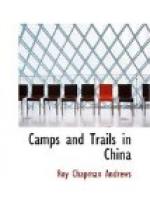The spot was redolent with the atmosphere of the lazy East; the East which, like the fabled “Lorelei,” weaves a mystic spell about the wanderer whom she has loved and taken to her heart, while yet he feels it not. And when he would cast her off and return to his own again she knows full well that her subtle charm will bring him back once more.
* * * * *
The next morning we entered Bhamo. It is a city of low, cool houses, wide lawns and tree-decked streets built on the bank of the muddy Irawadi River. Only a few miles away the railroad reaches Katha, and palatial steamers run to Mandalay and Rangoon. We called upon Mr. Farmer, the Deputy Commissioner, who offered the hospitality of the “Circuit House” and in the evening took us with him to the Club.
A military band was playing and men in white, well-dressed women, and officers in uniform strolled about or sipped iced drinks beside the tennis court. We felt strange and shy but doubtless we seemed more strange to them for we were newly come from a far country which they saw only as a mystic, unknown land.
On June 9, at noon, we embarked for the 1,200-mile journey to Rangoon, exactly nine months after we had ridden away from Yuen-nan Fu toward the Mountain of Eternal Snow. Our further travels need not be related here. When we reached civilization we expected that our transport difficulties were ended; instead they had only begun. India was well-nigh isolated from the Pacific and to expose our valuable collection to the attacks of German pirates in the Mediterranean and Atlantic was not to be considered even though it necessitated traveling two thirds around the world to reach America safely.
We left Rangoon for Calcutta, crossed India with all our baggage to Bombay, and after a seemingly endless wait eventually succeeded in arriving at Hongkong by way of Singapore. There we separated from our faithful Wu and sent him to his home in Foochow. It was hard to say “good-by” to Wu, for his efficient service, his enthusiastic interest in the work of the Expedition, and, above all, his willingness to do whatever needed to be done, had won our gratitude and affection. We ourselves went northward to Japan, across the Pacific to Vancouver, and overland to New York, arriving on October 1, 1917, nearly nineteen months from the time we left. We were never separated from our collections for, had we left them, I doubt if they would ever have reached America. It was difficult enough to gather them in the field, but infinitely more so to guide the forty-one cases through the tangled shipping net of a war-mad world.
They reached New York without the loss of a single specimen and are now being prepared in the American Museum of Natural History for the study which will place the scientific results of the Asiatic Zooelogical Expedition before the public.
* * * * *




